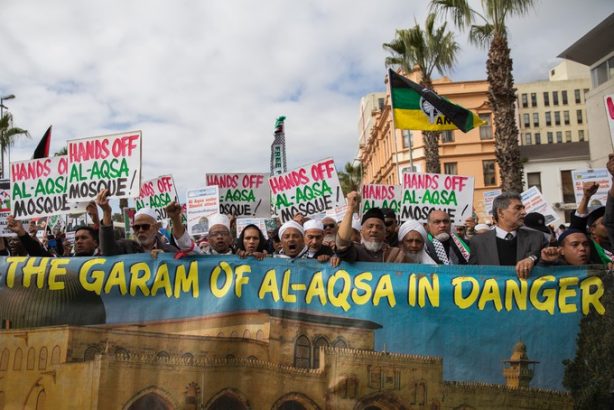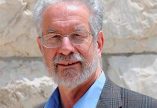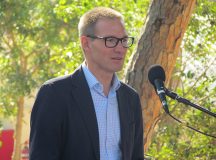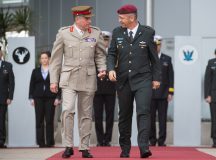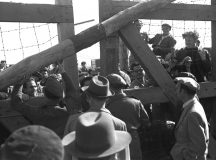In 1921 British politician Alfred Mond, visiting Palestine, said ‘our sanctuary, our Temple, we will construct as an everlasting building’. Yisrael Medad shows how, although Mond was plainly talking figuratively not literally, expressing his hopes for the rebirth of a nation. Arab political entrepreneurs, most notably the Grand Mufti, Haj Amin Al-Husayni, seized upon these remarks and throughout the 1920s employed them as a successful aid to political mobilisation, as fodder for anti-Zionist propaganda, and as a goad to violence. Still today, Mond’s remarks form part of the false narrative that ‘Al-Aqsa is under threat from the Jews’.
Introduction
Today, one often hears the false charge that Israel is ‘building tunnels under the Temple Mount‘, or that, ‘The Al-Aqsa Mosque is in danger of being bombed and destroyed. This is a true and serious Zionist threat’. There are dire warnings about how the ‘Jews invade the Mosque’ and even that Jews are ‘injecting chemical substances into the walls of the mosque in order to cause its corrosion’. This article examines one of the lesser-known origins of these myths and legends: remarks of the British politician Alfred Mond in 1921 which, though he subsequently clarified them, were purposefully distorted by the Arab leadership as a justification for violence for decades after.
Who was Alfred Mond?
Sir Alfred Moritz Mond (1868 – 1930), industrialist, plutocrat, politician and philanthropist, knighted as the 1st Baron Melchett, was born to parents who had immigrated to Great Britain from Germany. Although both his parents were born of Jewish parents, they did not consider themselves practicing Jews and he was not raised as a Jew. His wife, Violet (sister of the Foreign Office muralist Sigismund Christian Hubert Goetze), was also of Jewish heritage but her parents had converted. They were married in the Anglican Church and the children were raised as Christians.
Mond’s father, Ludwig, was a chemist and had emigrated from Germany to England in 1862. He developed a process for processing soda ash and later, another for extracting nickel. After founding a chemical engineering firm he became extremely wealthy in that he discovered that adding 3.5 per cent nickel to steel greatly increased its strength. Alfred was a director in his father’s businesses and expanded them. In 1926, he brought about the merger of four separate companies to form Imperial Chemical Industries (ICI), one of the world’s largest industrial corporations at the time and became its first chairman. He was one of the wealthiest Englishmen at the time.
He involved himself in politics and sat as Liberal Member of Parliament from 1906 to 1923, becoming a member of David Lloyd George’s government as First Commissioner of Works from 1916 to 1921 and Minister of Health (with a seat in the cabinet) from 1921 to 1922. He then switched party and sat in Parliament from 1924 to 1928. Upon his death the obituary of The Times noted he had triumphed over ‘a bad voice, a bad delivery, and a presence unimpressive to all but the caricaturists’.
Although not identifying as Jewish, nevertheless, Mond was frequently the victim of antisemitic attacks in Parliament. T.S. Elliot’s poem, ‘A Cooking Egg‘, published in 1920, includes these lines: ‘I shall not want Capital in Heaven, For I shall meet Sir Alfred Mond: We two shall lie together, lapt / In a five per cent Exchequer Bond,’ and he was targeted by Henry Hamilton Beamish (an early promoter of the Madagascar Plan for Jewish deportation to that island of the east coast of Africa) and his The Britons group which, in a poster, ‘The Jews’ Whose Who’, attacked Mond as a traitor to England.
Mond and Zionism
In the wake of the Balfour Declaration, he adopted the Zionist cause with fervor even though, according to Edwin Montagu’s October 1917 letter to the Cabinet (NA CAB21/58, ‘The Future of Palestine’), he had been previously opposed or, perhaps, non-supportive. He eventually became President of the British Zionist Foundation, invested in Pinchas Rutenberg’s Electric Corporation and he was a signee on the Keren Hayesod Manifesto, published on 24 December 1920 in the Jewish Chronicle, having been appointed Chairman of the Zionist fundraising instrument at the beginning of the month. At an event in Manchester in the first week of December, he was obliged to address a charge that appeared in the Morning Post that the Zionist was demanding a decisive role in the appointment of the High Commissioner.
Earlier that year, on 8 April 1920, Mond, then Minister of Health, expressing his view on the future of the Jewish national home in Palestine, had declared in a private letter to David Lloyd George that ‘to place a highly civilised world people like the Jews under the sovereignty of the quasi-barbarian and backward Arabs is unthinkable! Nor from a British standpoint, as a question of policy, could such an enhancement of the insatiable lust of domination of Mahomedan Arabs be anything but disastrous’ (David Lloyd George Papers, as cited in Maryanne A. Rhett, The Global History of the Balfour Declaration: Declared Nation, Routledge, 2016) and that it was the responsibility of the state to show the Arabs ‘how to become civilised’.
Moreover, in an earlier letter sent to Lloyd George on 13 October 1919, Mond expressed a similar ‘concern’ regarding the views of the Amir Feisal on Palestine, specifically, ‘the idea that Palestine should be part of an Arab Kingdom in which the Jews will be welcome but will in fact be governed by Arabs. This is so entirely contrary to the expressed policy of the British Government, that I so hope you will impress on him the intention of the Governments of the Allies regarding the Jews and their national home’. He further pressed that ‘there should be no weakening on this question’ which was causing him ‘a great deal of anxiety’.
Mond in Palestine
In early January 1921, Mond and Chaim Weizmann had arrived in Palestine, then still under British military occupation, having left England on 5 January. The purpose of his visit was to tour the land and observe the progress made by the Jewish pioneers — an on-site inspection, as it were. Indeed, his itinerary took him to cities and the kvutzot, from north to south.
On Sunday evening, 30 January, hundreds of guests congregated at the Lemel School in Jerusalem, up from the Bikkur Cholim Hospital and quite near to Meah Shearim. All strata of Jerusalem’s Jewish society were represented. Weizmann spoke and then Mond addressed the guests. Acknowledging that sharp criticism of the Zionist leadership had been conveyed to him, he asked that the assembled understand that he has full faith in their ability and requested that unity be the goal. Mutual recriminations can only have a negative effect on the Zionist work that needs to be done. World Jewry need be harnessed to assist the financial needs of the Yishuv.
According to press reports, Mond was planning, as soon as the League of Nations mandate over Palestine was confirmed, to raise a loan for the development of the country. He was impressed by the ‘unbounded enthusiasm’ displayed by Jews, some of whom were walking across Europe to get to their homeland even over a period of eleven months. It was a country of ‘mineral oil … phosphates and asphalt’.
Mond’s remarks about the Temple
According to the Hebrew language report of Haaretz on 1 February, he then said ‘our sanctuary, our Temple, we will construct as an everlasting building. Strong stones we will lay at its foundation. We are a stiff-necked people, even stubborn, in work and aspiration, and we will not lose hope’. The crowd, as the paper noted, reacted with applause, and he added, ‘the fourteen million Jews worldwide have one hope and will give their all to assure that our national home become a fact’. As it developed, that reference to the ‘Temple,’ symbolising the return of the national glory in a metaphorical sense, would almost be his doom. Incidentally, Mond’s biographer, Hector Bolitho, note in Alfred Mond, First Lord Melchett, that when Mond arrived at the Western Wall, he exclaimed:
‘My God, I should like to blow it up. It is terrible! It is terrible! It is the symbol of their humiliation and of the death of their pride. It is not in this way that they will build a nation or a people. In this is only further destruction: not escape.’
Back home, Mond, in a speech in London before the Palestine Foundation Fund [the Keren HaYesod] on 21 March 1921, repeated his appeal for a new ‘edifice’ to be erected ‘that would testify to the legacy of Solomon’s Temple’ as reported in the Daily Telegraph. Mond declared he would dedicate his remaining energies to the construction of a steadfast structure ‘on the site on which Solomon’s Temple once stood’.
Interestingly enough, in an interview in the local Meraat al-Shark (Mir’at al-Sharq/Mirror of the East) Arabic-language newspaper as quoted in Haaretz on 8 February, there was no mention of Mond’s supposedly inflammatory words. To the contrary, Mond was quoted in this organ of the Nashashibi faction as advancing an appreciation of the centuries-long Arab presence in the country, which needed to be taken into consideration. The country’s culture would be a mixed Jewish and Arab one, Mond was quoted, who also identified a need for joint Jewish-Arab cooperation in economic affairs for the country required an input of finances and a labor force.
Questions in Parliament
On 5 April 1921, Conservative MP for Maidstone Commander, Carlyon W. Bellairs, put a question to the prime minister that was answered by Leopold Amery, his Parliamentary Secretary. Bellairs had asked whether the prime minister’s ‘attention has been drawn to the proposal put forward at a meeting of the Palestine Foundation Fund to erect a great temple on the site of the Temple of Solomon; whether he is aware that the site is now occupied by the Mosque of Omar; and whether, in view of the difficulties which such proposals cause to the Mandatory Powers, he will state that in no circumstances will Mohammedan institutions be interfered with?’
Amery’s response was that those words were a passage ‘in a speech delivered by my right hon. Friend the Minister of Health [Mond], to which the hon. and gallant Member apparently alludes. I think it is clear that my right hon. friend was speaking figuratively and did not intend so literal an interpretation to be given to his words’.
He then drew attention to Article 13 of the draft Mandate for Palestine ‘which clearly sets forth the policy of His Majesty’s Government with regard to all holy places, religious buildings, or sites in Palestine’.
The very pro-Zionist MP of Kingston upon Hull Central, Lieut.-Commander Joseph Kenworthy, Baron Strabolgi — who had intervened a year earlier on behalf of Ze’ev Jabotinsky, arrested for the defence of Jerusalem during the Arab riots and who, in November 1928, would attack the newly implemented status quo regulations at the Western Wall as discriminatory towards the Jews — asked a supplementary question:
‘Is the hon. and gallant Gentleman aware that there is no intention whatever of interfering with any mosques by the Palestine Committees, and also that King Solomon is held in equal reverence by Mohammedans, Jews, and Christians?’
Edward Turnour, Earl of Winterton, objecting to any interference with ‘holy places’, then wished to know if Amery will ‘convey to the Minister of Health the un-desirability of making the sort of figurative speech which he did, in view of Mohammedan susceptibilities’? Amery indicated that he could not be ‘responsible for the extent of misinterpretation which may be put on figurative speeches, but it is certainly the case, as my Noble Friend stated, that a guard has been on the Mosque of Omar ever since the occupation, and there is every intention of safeguarding the holy places of every religion’.
Enter Al-Husayni: A Political Entrepreneur
According to Nicholas E. Roberts, Mond’s words intersected with the electioneering literature distributed by Amin Al-Husayni in 1921 when on the night of 19 April his supporters pasted up a poster entitled ‘Wake Up Moslems’, accusing his rivals of willingly handing over the Haram al-Sharif to the Jews so that its buildings, the Dome of the Rock and al-Aqsa, might be pulled down and the Temple be rebuilt ‘as stated by Alfred Mond and the president of the Zionist Commission David Eder’ (p. 109).
Back in Palestine, according to Haaretz of 10 August that same year, Mond’s words about a newly reconstructed Temple were still agitating the Arab population. The High Commissioner, Herbert Samuel, felt it necessary to request further clarification. The response from the Colonial Office, with assistance from William G. A. Ormsby-Gore, who had just been appointed to the post of British Representative to the Permanent Mandates Commission, was that Mond was using figurative speech as regards the country as a whole and had no intention to relate to any specific area upon which, ‘according to the legend, Solomon’s Temple once stood’.
The Mufti Haj Amin Al-Husayni seized upon these remarks and throughout the 1920s they were employed as a successful aid to mobilisation, as well as fodder for anti-Zionist propaganda. The attempts (see p. 141) made by Zionists to purchase the West Wall courtyard, of Weizmann, Rabbi Kook, Yaakov Thon and others, seemed to confirm what Al-Husayni was saying about Mond’s words. Already on 1 May 1918, Weizmann had written to Ormsby-Gore that a conveyance of the Western Wall to the Jews, currently ‘surrounded by ill-kept, ramshackle buildings’ and ‘the haunt of Arab loafers and vagrants’, for fair market value, reportedly £75,000, would return ‘dignity and solemnity which should attach to this monument of the ancient glories of Israel’ rather than a scene ‘of humiliation and degradation’. As he elucidated, ‘We feel that the present time, when Jewry is looking forward to a revival of its national life, would be of all times the most fitting for the carrying out of this project.’
Sheikh Abd al-Qadir al-Muzaffar Takes the Myth to the Muslim World
Sheikh Abd al-Qadir al-Muzaffar, who headed in 1922 the first of several delegations that toured the Moslem world, especially Mecca during the Hijaz season, published manifestos beginning that year which utilised the theme of a Jewish ‘takeover’ of the Haram area. On 23 July, Doar HaYom published a rebuttal to the pamphlet and, inter alia, refuted the claim that Mond had proclaimed he would devote the rest of his life to ‘the restoration of Solomon’s Temple on the ruins of the Mosque of al Aqsa’, a quotation frequently quoted (see below). Roberts describes these delegations of the Supreme Muslim Council as ostensibly raising funds for the renovation of the Dome of the Rock but an added element was a call on Muslims ‘to rally to its defence of the Haram al-Sharif’.
The idea to renovate the Dome of the Rock originally came from a Jew and Zionist, High Commissioner Herbert Samuel. In August 1920, he wrote to Lord Curzon to request that the British government provide funds to renovate the Haram al-Sharif. Correctly foreseeing that if the British repaired the site, Muslims would protest ‘that Britain was taking over an Islamic space’, Samuel, the secretary of state, and the viceroy of India decided that it would be better for Hajj Amin al-Husayni to lead the campaign to repair the site with Britain providing background technical and financial assistance. However, al-Muzaffar and his comrades spread a very different message when visiting Egypt, the Sudan, Iraq, the Hejaz, Kuwait, Bahrain and India. British observers of the next three trips made between 1923–1924 observed the injection of nationalist politics into their fundraising appeal. Quite simply, they added to their message that monies collected ‘would also help to defend the Haram al-Sharif from Zionist takeover’.
While on tour in America in 1928, Mond admitted in a speech on 26 October, as reported in the 9 November edition of Philadelphia’s The Jewish Exponent, that the proposed purchase of the Wall was ‘not feasible now’. But, he added, ‘the Zionist Organization is determined to force the issue and obtain a definite arrangement with the government or parties concerned’ for regular Jewish assemblies to worship at the Wall.
Mond’s utterances were constantly highlighted by Arab spokespersons throughout the 1920s and particularly during the Western Wall dispute of September 1928-August 1929. As Thomas Adam has noted, Mond’s Zionist ‘activities found opponents in the Arab world, and Mond was quickly targeted for plans to destroy Arab religion and culture. In 1928 the influential Cairo newspaper Mokattam accused Mond of having said “I shall devote the rest of my life to the restoration of Solomon’s Temple on the ruins of the Mosque of al Aqsa”’.
In 1930, Emil Ludwig published an article in the New York Times surveying the scene in Palestine. Towards its end, he wrote, ‘Only by mutual understanding can the Arabs and the Jews live together in this country…No prudent Zionist speaks any longer of the Jewish State of Palestine, but all speak of a home in Palestine. The first would be as senseless as the published assertion of the Arabs that Sir Alfred Mond and Einstein wanted to erect again the Temple of David.’ In 1934 David Ben-Gurion, meeting Mussa Alami, then employed in the Legal Department of the Mandatory Government, heard Alami express alarm about Mond’s statement. (See Ben-Gurion’s memoir Zikhronot, 1972, p. 170).
The Myth, from the 1929 Riots to Today
Disturbances from September 1928 to August 1929 culminated in Arab-instigated riots throughout Mandate Palestine. The notion that a Jewish drive to restore the Temple and erase al-Aqsa must be resisted was central to Arab propaganda throughout this period.
On 8 October 1928, the Mufti submitted a memorandum pointing to ‘the unlimited greedy aspirations of the Jews in this respect, Moslems believe that the Jews’ aim is to take possession of the Mosque of Al-Aqsa gradually on the pretence that it is the Temple, by starting with the Western Wall of this place, which is an inseparable part of the Mosque of Al-Aqsa’ (See the 1929 Commission’s report, p. 31).
On 1 November 1928 a meeting of the new General Moslem Conference was convened and a resolution was passed reading, ‘Whereas we, the population of the Holy Land, have been entrusted by God with the custody of this House and His Temple, we deem it our duty to submit to all our Moslem brethren in the East and West a statement of the danger which threatens this Mosque owing to the ambitions of the Jews to expropriate it from the hands of Moslems.’ Thus were Mond’s words recalled and recycled as part of the propaganda efforts.
A Commission of Inquiry arrived in the country in October 1929. As its report accepts, ‘the Mufti or any educated Moslem might — genuinely and not without reason —have feared that, if at some future time the Jews became politically dominant in Palestine, they would not be content to leave the old Temple Area in Moslem ownership. No declaration by the Zionist Organization could remove such a fear.’ (p.73)
When the Mufti presented evidence before the Shaw Commission on 2 December 1929, the issue of Mond’s remarks were part of his cross-examination and correspondence dating to July 1921 was reviewed (p. 498). The follow-up International Commission report on the Western Wall of December 1930 specifically included Mond in its summary entitled ‘The real intentions of the Jews’:
‘Lord Melchett (then Sir Alfred Mond) has declared in public (1922) that the day of the reconstruction of the Temple was very near. Jabotinsky, Zangwill [who had written of the rise of a ‘new Cyrus’ who would pave the way for a ‘new Nehemiah’], Professor Klausner of the Hebrew University of Jerusalem, and other prominent Jews have expressed themselves to the same effect. Pictures to be found in sundry Jewish papers also show it to be the intention of the Zionists to rebuild the Temple at the spot that is now occupied by the Haram-esh-Sherif.’
The Mufti conducted a pan-Islam World Islamic Congress in Jerusalem in 1931 and again, Mond’s words and the theme of replacing the Haram al-Sharif with a Third Jewish Temple was played up. Since then, and until today, the theme of ‘Temple-Replacing-Mosque’ and the ‘Judaisation of the Temple Mount’ fill the Palestinian Authority media and their diplomatic initiatives and the UN and additional international forums incessantly, consistently and constantly.

